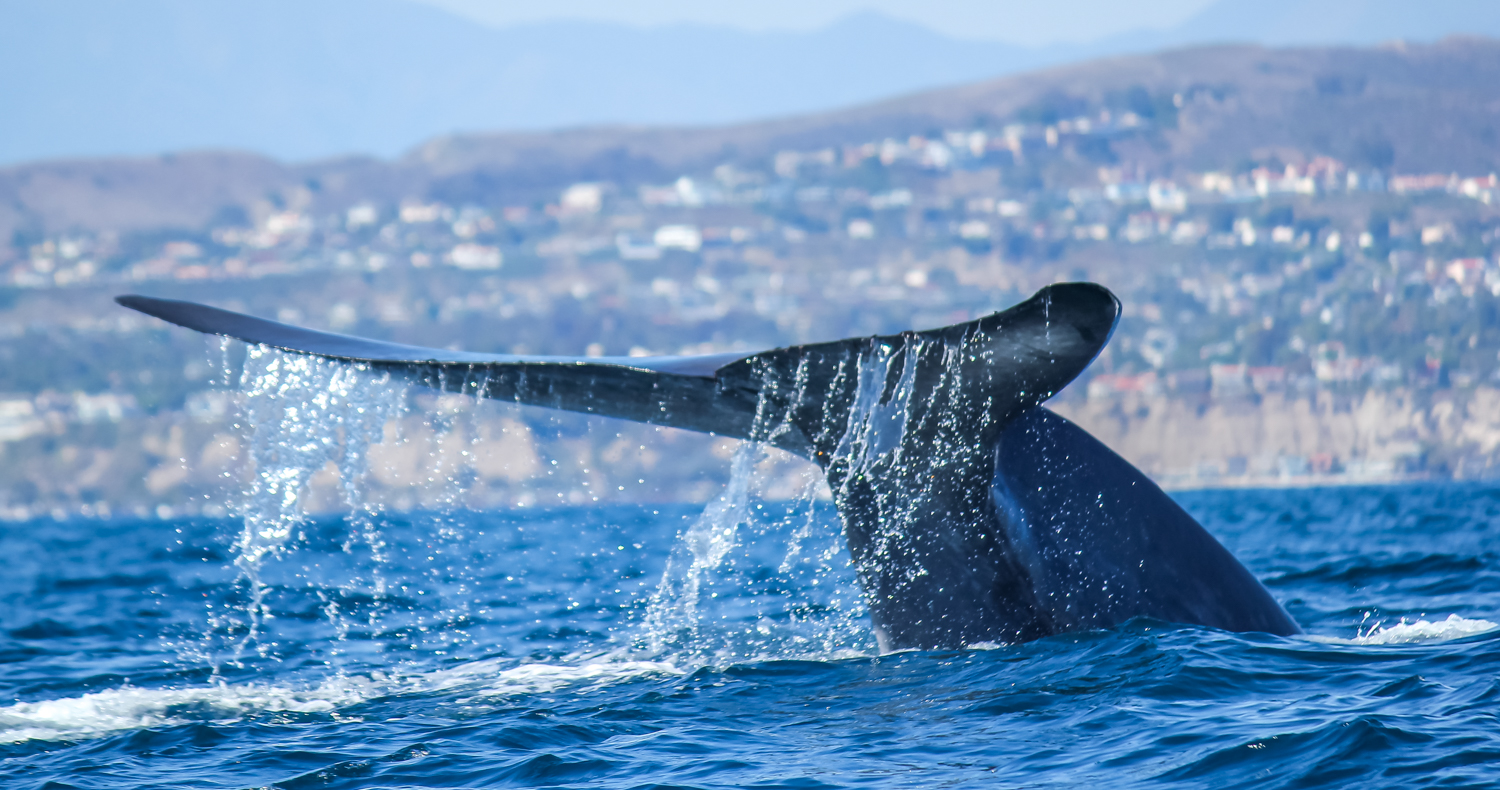Are Blue Whales Friendly?

May is the unofficial start to blue whale season, and seeing one of the world’s magnificent gentle giants roaming free in the sea may be rare in other parts of the world, but right here in Dana Point, California, we anxiously await this time of year! If you wonder, “are blue whales friendly” and are curious about seeing one, we have all the answers right here!

Blue Whale
The best time to go whale watching to see the largest animal to have ever lived on land or sea is during the summertime in sunny Southern California. From land to sea and everywhere in between, whales are a part of the culture here in Dana Point, the Whale Watching Capital of the World®. Known as a top whale watching destination globally for having more species of whales and dolphins than any other place on earth, Dana Point was recently inducted as the first-ever Whale Heritage site in America. We invite you to book a safari tour with us today and learn more about the incredible mammals sharing the ocean with us, including the not-so-rare blue whale that is not so rare we are lucky to see here all summer long.
Being the largest mammal on earth can be daunting when you see them in the open ocean as their sheer size trumps the size of our largest boat! Some of our youngest passengers ask a common question: “Are blue whales friendly?” And, the answer is a simple yes! While their size may be enormous and their appetite bigger than anything else to have ever walked or swam on earth, Balaenoptera musculus, or blue whale, has a calm disposition, as peaceful and serene as their ocean home below the surface. Unless, of course, you are krill. Swooping up nearly 3 tons of krill per day, blue whales gently glide through our deep offshore waters from June – to October in search of the abundance of krill. Sometimes blue whales will stay in the same location for a few days, giving passengers ample time on our trips to experience the answer to the question, “Are blue whales friendly.”
Calories count when it comes to their young too. Newborn baby blue whales enter the world already weighing over 500 pounds, stretching out as long as nearly 20 feet! Now that is a big baby! Blue whale calves will gain over 200 pounds per day drinking mom’s rich fatty milk. Blue whale babies grow fast at one and a half inches per day until they reach their long lengths of over 80 feet for males and up to 100 feet for females. Growing to these lengths doesn’t take long. Blue whales will reach their sexual maturity between six and ten years or when they reach near full-grown lengths of approximately 74 feet for males and 79 feet respectively for females.
Many passengers are also curious “Are blue whales friendly when communicating with each other?” The life of a blue whale is pretty lonely. Traveling most places alone, or sometimes with their calf, blue whales use a form of stereotyped calls to communicate with other whales throughout the year. Described as pulses, grunts, groans, and moans typically in the 15-40 Hz range, these sounds are often below the threshold of human hearing but can be heard by other traveling whales up to 1000 miles away! This communication could be whales sharing the knowledge of danger lurking in the nearby currents or letting others know that they are feasting on krill nearby. Because blue whales can consume up to 40 million krill each day, it is necessary to spread out, so there is enough food to be had by all, but there is also evidence that they share information when they find an area that is rich in krill. In this way, they help their entire community to survive and thrive with as little energy expended as possible. So in this regard, if you are wondering whether or not blue whales are friendly to other blue whales, we would say that the answer is yes.
Blue whales are gulp feeders. They have ventral pleats that open like a balloon filling their mouths with thousands of pounds of water and food. Baleen plates line the inside of their mouths in place of teeth. Baleen plates are composed of a keratin-like material, much like our fingernails. When it is feeding time, blue whales feed by taking a giant mouthful of water and krill, opening their throats like giant balloons. They then push the water out with their tongues through the baleen expelling all the seawater while trapping the leftover krill inside using their magnificently engineered baleen plates.
Are blue whales friendly while feeding isn’t just a follow-up question from kids. Many passengers are curious just how big blue whales are AND if they are aggressive hunters. Tipping the scales at a mere 300,000 pounds, calories mean everything to a blue whale. And the more they weigh, the better their survival rate becomes. Deadly mammals known for being unfriendly to blue whales are orcas, and when hunting young and smaller blue whales, Orca is a vicious killer and as unfriendly as they come. Are blue whales friendly around these ferocious ocean predators? They don’t have much choice. It is survival of the fittest in the big deep blue sea, and Balaenoptera musculus is no match for killer whales, even with their sizeable girth giving them an advantage. Orcas are brilliant and will hunt in packs, making them no match for anything in the sea. Certainly not a blue whale youngster!!
Although blue whales can reach top speeds of 30 miles per hour when trying to flee the scene of an Orca encounter or attack, they generally cruise at about 12 miles per hour. Their fluke is their trademark and is between 20-25 feet wide! Unlike many smaller baleen whales amongst the family of great rorqual whales, the enormous weight of 100-150 tons of Balaenoptera musculus prevents them from breaching. If you can’t fathom that size, it is approximately 85 mid-size cars or eight large school buses. Now that is HUGE! If given a chance to see their stunning tails, “are blue whales friendly” is no longer the question, and instead, passengers wonder how many other people have had the chance to see this magnificent sight? If you get this gift on a sightseeing tour, you are lucky. One out of five blue whales will show their tails, and when they do, we promise this is something you will NOT forget!
While alone in the wild, sighting blue whales is tremendous. But, some whale species are notable for aggressive temperaments when under threat. When determining if blue whales are friendly, we must remind our readers that in the late 1800s and again in the early 1900s, some whale species were hunted by whalers. Stabbed to death with deadly harpoons for the presumed precious oil thought to exist within whale blubber, whalers nearly devastated several whale species trying to reap the rewards of this. During this time, Eschrichtius robustus, commonly called gray whales, were heartbreakingly hunted to near extinction. Whalers threatening the livelihoods of gray whales and their offspring with these deadly harpoons was the foundation for their often aggressive and sometimes fatal attacks on whalers. Coined “devil fish” and under threat, gray whales became known for being unfriendly, unlike blue whales. But who could blame them?
Are blue whales friendly like the gray whales in Mexico?
Massacres of whales decimated hundreds of thousands of populations of gray whales down to grave numbers at the turn of the 20th century. Historical research paints a much different picture, but today, modern research shows us that whales are and always have been typically a friendly species. Today when whales are spotted, their relationships with humans are now amicable, social, and inquisitive. On some occasions, some mothers make sure we all catch a glimpse of their beautiful and graceful little ones and sometimes, bring them right near our boats! With growing numbers, even the now protected gray whales who were once aggressive towards humans, have shown they instinctively have the power to forgive.
Are blue whales friendly enough to touch?
It is crucial to remember when you are out whale watching, regardless of who you book your trip with, that your Captain remains a safe distance from all whale and dolphin species. Whales and dolphins are now protected under the Marine Mammal Protection Act and Endangered Species Act. If a whale is interested and chooses by its own accord to swim nearby, always remember to stay neutral and be respectful of the whale’s space. It is critical that amateur and professional boaters NEVER cross the path of a traveling whale. Staying behind the animal’s directional path at all times gives whales the room they need as they travel to their desired destinations. Keeping a safe distance creates a safe space for animals to continue their journey.
Did you know that only 1% of all people on Earth will ever actually see a blue whale? Seeing a friendly ocean goliath is an extraordinary sight to see. Join us on a trip today! No matter how many times you are lucky enough to capture a glimpse of these awe-striking beauties, you will be reminded that the best time to go whale watching in Southern California is a day where blue whales could be on your sightseeing list! As you plan your summer vacations, staycations, and local fan-favorite attractions looking for an experience that you will NEVER forget then Dana Point whale watching is the perfect excursion for you! Capt. Dave’s Whale Watching is waiting for you, and we cannot wait to bring you aboard to create a unique experience that your whole family will enjoy. Join us aboard Manute’a, our flagship state-of-the-art catamaran with underwater viewing pods perfect for going down below and seeing what it is like to swim with the dolphins. Like something with a little more adventure? Take a trip on the fastest whale watching boats in the Dana Point Harbor and tour the seas aboard our super-safe and speedy adventure zodiac tours. We have you covered if you have a larger group or are looking for something smaller and intimate. Lily and Orca are perfect for your private charters, whether your group is large or small.
While summer may be the best time to see blue whales, don’t forget that the best whale watching in Orange County happens every day, all year long in Dana Point, the Whale Watching Capital of the World®.
Until then,
Jess Wright
First Mate and Marine Naturalist
Capt. Dave’s Dolphin & Whale Watching Safari
